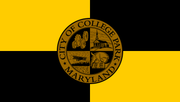College Park, Maryland
| College Park, Maryland | |||
|---|---|---|---|
| City | |||
| City of College Park | |||
| |||
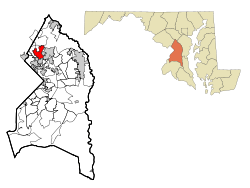 | |||
| Coordinates: 38°59′48″N 76°55′39″W / 38.99667°N 76.92750°WCoordinates: 38°59′48″N 76°55′39″W / 38.99667°N 76.92750°W | |||
| Country |
| ||
| State |
| ||
| County |
| ||
| Founded | 1856 | ||
| Incorporated | 1945 | ||
| Area[1] | |||
| • Total | 5.68 sq mi (14.71 km2) | ||
| • Land | 5.64 sq mi (14.61 km2) | ||
| • Water | 0.04 sq mi (0.10 km2) | ||
| Elevation | 69 ft (21 m) | ||
| Population (2010)[2] | |||
| • Total | 30,413 | ||
| • Estimate (2012[3]) | 31,208 | ||
| • Density | 5,392.4/sq mi (2,082.0/km2) | ||
| Time zone | EST (UTC−5) | ||
| • Summer (DST) | EDT (UTC−4) | ||
| ZIP codes | 20740–20742 | ||
| Area code | 301 | ||
| FIPS code | 24-18750 | ||
| GNIS feature ID | 2390578 | ||
| Website | www.collegeparkmd.gov | ||
College Park is a city in Prince George's County, Maryland.[4] The population was 30,413 at the 2010 United States Census. It is best known as the home of the University of Maryland, College Park, and since 1994 the city has also been home to the "Archives II" facility of the U.S. National Archives, and is also home to the National Oceanic and Atmospheric Administration (NOAA) Center for Weather and Climate Prediction (NCWCP).[5]
College Park's United States Postal Service ZIP codes are 20740, 20741 (Berwyn Heights; North College Park) and 20742 (University of Maryland).
History
Development
College Park was developed beginning in 1889 near the Maryland Agricultural College (later the University of Maryland) and the College Station stop of the Baltimore and Ohio Railroad. The suburb was incorporated in 1945 and included the subdivisions of College Park, Lakeland, Berwyn, Oak Spring, Branchville, Daniel's Park, and Hollywood. The original College Park subdivision was first plotted in 1872 by Eugene Campbell. The area remained undeveloped and was re-platted in 1889 by John O. Johnson and Samuel Curriden, Washington real estate developers. The original 125-acre (0.51 km2) tract was divided into a grid-street pattern with long, narrow building lots, with a standard lot size of 50 feet (15 m) by 200 feet (61 m). College Park developed rapidly, catering to those who were seeking to escape the crowded Washington, D.C., as well as to a rapidly expanding staff of college faculty and employees. College Park originally included single-family residences constructed in the Shingle, Queen Anne, and Stick styles, as well as modest vernacular dwellings. Commercial development increased in the 1920s, aided by the increased automobile traffic and the growing campus along Baltimore Avenue / Route 1. By the late 1930s, most of the original subdivision had been partially developed. Several fraternities and sororities from the University of Maryland built houses in the neighborhood. After World War II, construction consisted mostly of infill of ranch and split-level houses. After incorporation in 1945, the city continued to grow and build a municipal center in 1959.[6]
The Lakeland neighborhood was developed beginning in 1892 around the Baltimore and Ohio Railroad, whose Branchville and Calvert Road depots were located approximately one mile to the north and south, respectively. Lakeland was created by Edwin Newman, who improved the original 238 acres (0.96 km2) located to the west of the railroad. He also built a number of the original homes, a small town hall, and a general store. The area was originally envisioned as a resort-type community. However, due to the flood-prone, low-lying topography, the neighborhood attracted a lower-income population became an area for African-American settlement. Around 1900, the Baltimore Gold Fish Company built five artificial lakes in the area to spawn goldfish and rare species of fish. A one-room school was built in 1903 for the African-American population; a new school was built in 1925.[6]
The Berwyn neighborhood was developed beginning about 1885 adjacent to the Baltimore and Ohio Railroad. It was created by Francis Shannabrook, a Pennsylvanian who purchased a tract of land between Baltimore Avenue and the railroad tracks. Shannabrook established a small depot, built a general store, and erected approximately 15 homes in the area to attract moderate-income families looking to move out of Washington. The neighborhood began to grow after 1900 when the City and Suburban Electric Railway entered the area. By 1925 there were approximately 100 single-family homes; mostly two-story, wood-frame buildings. The community housing continued to develop in the 1930s and 1940s with one story bungalows, capes, and Victorians, and later grew to include raised ranches and split level homes.[6]
The Daniels Park neighborhood was developed beginning in 1905 on the east and west sides of the City and Suburban Electric Railway in north College Park. Daniels Park was created by Edward Daniels on 47 acres (19 ha) of land. This small residential subdivision was improved with single-family houses arranged along a grid pattern of streets. The houses range in style from American Foursquares to bungalows, and were built between 1905 and the 1930s.[6]
The Hollywood neighborhood was developed beginning in the early 20th century along the City and Suburban Electric Railway. Edward Daniels, the developer of Daniels Park, planned the Hollywood subdivision as a northern extension of that earlier community. Development in Hollywood was slow until after World War II when Albert Turner acquired large tracts of the northern part of the neighborhood in the late 1940s. Turner was able to develop and market brick and frame three-bedroom bungalows beginning in 1950. By 1952, an elementary school had been built. The Hollywood Park, a 21-acre (8.5 ha) facility along the Baltimore and Ohio Railroad line, is operated by the Maryland-National Capital Park and Planning Commission.[6]
Later events
In 1943, the Washington Senators held their spring training camp in College Park. To conserve rail transport during World War II, the location of the 1943 Major League Baseball spring training camps was limited to an area east of the Mississippi River and north of the Ohio River.[7]
On September 24, 2001, a multiple-vortex F3 tornado hit the area. This storm moved at peak intensity through the University of Maryland, College Park campus, and then moved parallel to I-95 through the Laurel area, where F3 damage was also noted. The damage path from this storm was measured at 17.5 miles (28.2 km) in length, and this tornado caused two deaths and 55 injuries, along with $101 million in property damage. The two deaths were sisters who died when their car was picked up and hurled over a building before being slammed to the ground; both young women were University of Maryland students.[8] This tornado was part of the Maryland, Virginia, and Washington, D.C., tornado outbreak of 2001, one of the most dramatic recent tornado events to directly affect the Baltimore-Washington metropolitan area.
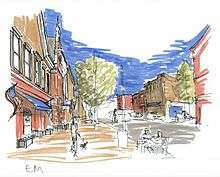
By the turn of the 21st century, College Park began experiencing significant development pressure. Both students and city residents have acknowledged the city's lack of amenities and poor sense of place. In 2002, the city and county passed the Route 1 Sector Plan, which allowed and encouraged mixed use development on College Park's main roadway. Recent projects like the East Campus Redevelopment Initiative, the University View and Northgate Condos give many in the community hope that the city may one day be like other notable college towns around the country, with a vibrant downtown and a diverse population. The University of Maryland's Student Government Association sponsored a design charrette in April 2006 to envision the future of College Park. In July 2006, a group of students created Rethink College Park—a community group providing a website to share information about development and encourage public dialogue. As of 2010, there have been notable architectural additions to the city of College Park, Maryland. A parking garage was completed in the downtown area in August 2009 near the intersection of Route 1 and Knox Road. The View apartments completed two new towers to add to their apartment complex, and next to the View apartments, graduate school apartment towers were being constructed.
Demographics
| Historical population | |||
|---|---|---|---|
| Census | Pop. | %± | |
| 1950 | 11,170 | — | |
| 1960 | 18,482 | 65.5% | |
| 1970 | 26,156 | 41.5% | |
| 1980 | 23,614 | −9.7% | |
| 1990 | 21,927 | −7.1% | |
| 2000 | 24,657 | 12.5% | |
| 2010 | 30,413 | 23.3% | |
| Est. 2015 | 32,301 | [9] | 6.2% |
The median income for a household in the city was $50,168, and the median income for a family was $62,759 (these figures had risen to $66,953 and $82,295 respectively as of a 2007 estimate[11]). Males had a median income of $40,445 versus $31,631 for females. The per capita income for the city was $16,026. About 4.2% of families and 19.9% of the population were below the poverty line, including 6.9% of those under age 18 and 9.2% of those age 65 or over.
2010 census
As of the census[2] of 2010, there were 30,413 people, 6,757 households, and 2,852 families residing in the city. The population density was 5,392.4 inhabitants per square mile (2,082.0/km2). There were 8,212 housing units at an average density of 1,456.0 per square mile (562.2/km2). The racial makeup of the city was 63.0% White, 14.3% African American, 0.3% Native American, 12.7% Asian, 0.1% Pacific Islander, 6.0% from other races, and 3.5% from two or more races. Hispanic or Latino of any race were 11.9% of the population.
There were 6,757 households of which 18.4% had children under the age of 18 living with them, 30.6% were married couples living together, 7.9% had a female householder with no husband present, 3.7% had a male householder with no wife present, and 57.8% were non-families. 24.8% of all households were made up of individuals and 6.6% had someone living alone who was 65 years of age or older. The average household size was 2.79 and the average family size was 3.18.
The median age in the city was 21.3 years. 7.6% of residents were under the age of 18; 60.7% were between the ages of 18 and 24; 15.7% were from 25 to 44; 11% were from 45 to 64; and 5.1% were 65 years of age or older. The gender makeup of the city was 53.1% male and 46.9% female.
2000 census
As of the census[12] of 2000, there were 24,657 people, 6,030 households, and 3,039 families residing in the city. The population density was 4,537.5 people per square mile (1,753.2/km²). There were 6,245 housing units at an average density of 1,149.2 per square mile (444.1/km²). The racial makeup of the city was 68.82% White, 15.93% Black or African American, 0.33% Native American, 10.03% Asian, 0.01% Pacific Islander, 2.57% from other races, and 2.31% from two or more races. 5.54% of the population were Hispanic or Latino of any race.
There were 6,030 households out of which 19.8% had children under the age of 18 living with them, 38.6% were married couples living together, 8.3% had a female householder with no husband present, and 49.6% were non-families. 25.7% of all households were made up of individuals and 9.1% had someone living alone who was 65 years of age or older. The average household size was 2.65 and the average family size was 3.11.
In the city the age distribution of the population shows 10.5% under the age of 18, 51.3% from 18 to 24, 19.8% from 25 to 44, 11.3% from 45 to 64, and 7.2% who were 65 years of age or older. The median age was 22 years. For every 100 females there were 110.3 males. For every 100 females age 18 and over, there were 111.2 males.
Government
The Government of College Park is a Council-Manager form of government. The city manager is appointed by the city council and the mayor elected every two years. The council has eight members, representing four districts in the city. City Council meetings are held once a week at the College Park City Hall.
The current Mayor of College Park is Patrick L. Wojahn, who took office in 2015. Previous mayors were:
|
|
College Park has six government departments:
|
|
As of September 2011, College Park belongs to Maryland's 5th congressional district.
Geography
College Park is located at 38°59′48″N 76°55′39″W / 38.99667°N 76.92750°W (38.996560, -76.927509).[13]
According to the United States Census Bureau, the city has a total area of 5.68 square miles (14.71 km2), of which, 5.64 square miles (14.61 km2) is land and 0.04 square miles (0.10 km2) is water.[1]
Climate
The climate in this area is characterized by hot, humid summers and generally mild to cool winters. According to the Köppen climate classification system, College Park has a humid subtropical climate, abbreviated "Cfa" on climate maps.[14]
Neighborhoods
|
|
|
Bordering areas
- Beltsville (North)
- Berwyn Heights (East)
- University Park (Southwest)
- Riverdale Park (South)
- Adelphi (West)
- Hyattsville (Southwest)
Economy
According to the City's 2015 Comprehensive Annual Financial Report,[15] the top employers in the city are:
| # | Employer | # of Employees |
|---|---|---|
| 1 | University of Maryland, College Park | 15,720 |
| 2 | University of Maryland University College | 2,000 |
| 3 | National Oceanic and Atmospheric Administration | 825 |
| 4 | Food and Drug Administration | 800 |
| 5 | National Archives and Records Administration | 689 |
| 6 | American Center for Physics | 500 |
| 7 | Ikea | 450 |
Transportation
Airport
College Park Airport is one of the oldest continuously operating airports in the United States and is one of the oldest airports in the world, having been in continuous operation since 1909. Its future status is uncertain, as it lies just a few miles outside the restricted airspace of Washington, D.C. In 1977, the airport was added to the National Register of Historic Places.[16]
Major highways
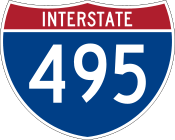 I-495 joins
I-495 joins  I-95 at the College Park Interchange, connecting with Alexandria and Baltimore. West of the interchange, I-495 continues west toward Silver Spring, Maryland and Northern Virginia.
I-95 at the College Park Interchange, connecting with Alexandria and Baltimore. West of the interchange, I-495 continues west toward Silver Spring, Maryland and Northern Virginia. US 1 is a major north-south roadway running through College Park, serving as the main street in the downtown area. It is a major route to Beltsville and Laurel to the north and Hyattsville and Washington, D.C. to the south.
US 1 is a major north-south roadway running through College Park, serving as the main street in the downtown area. It is a major route to Beltsville and Laurel to the north and Hyattsville and Washington, D.C. to the south.
Public transportation
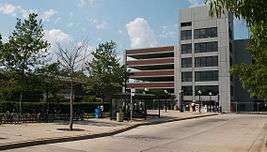
College Park–University of Maryland Station on the Washington Metro's Green Line is in College Park; a large commuter parking garage was completed in 2004 adjacent to the Metro station. MARC trains run on CSX tracks adjacent to the Green Line and stop at a small station next to the College Park Metro station. The Metro station lies at what had been the historic junction of Calvert Road and the CSX tracks.
College Park had streetcar service from 1903 to 1962 along what is now Rhode Island Avenue and the College Park Trolley Trail.
Historic sites
The following is a list of historic sites in College Park identified by the Maryland-National Capital Park and Planning Commission.[17] Part of the city is located within the Calvert Hills Historic District; listed on the National Register of Historic Places in 2002.[18]
| Site name | Image | Location | M-NCPPC Inventory Number | Comment | |
|---|---|---|---|---|---|
| 1 | Baker-Holliday House | 5005 Huron Street | 66-027-24 | Located in Daniels Park. | |
| 2 | Bowers-Sargent House | 9312 Rhode Island Avenue | 66-027-28 | Located in Daniels Park. | |
| 3 | College Park Airport | 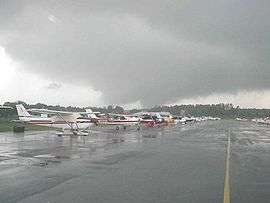 |
6709 Corporal Frank S. Scott Drive | 66-004 | Listed on the National Register of Historic Places, September 23, 1977 |
| 4 | College Park Woman's Club | 4711 Knox Road | 66-021-09 | Owned by the City of College Park. | |
| 5 | Cory House |  |
4710 College Avenue | 66-021-08 | |
| 6 | Holbrook House | 4618 College Avenue | 66-021-31 | ||
| 7 | Lake House (Presbyterian Parsonage) | 8524 Potomac Avenue | 66-018 | Located in Berwyn. | |
| 8 | LaValle House | 5013 Huron Street | 66-027-25 | Located in Daniels Park. | |
| 9 | McDonnell House | 7400 Dartmouth Avenue | 66-021-10 | ||
| 10 | National Archives Archeological Site | Address Restricted | 66-036 | Listed on the National Register of Historic Places, August 22, 1996 | |
| 11 | The Rossborough Inn | |
Baltimore Avenue (US 1) | 66-035-02 | Located on the University of Maryland campus. |
| 12 | Taliaferro House | 7406 Columbia Avenue | 66-021-30 |
Media
- UMTV (University of Maryland)
- WMUC broadcasts from the University of Maryland campus, with a range of two (2) miles (3 km) – roughly from the campus to the Beltway. It is also broadcast over the internet at www.wmucradio.com.[19]
- The Diamondback, a student publication, is distributed five days a week on a limited basis downtown, including in city hall, and widely on the campus of the University of Maryland.
- A College Park edition of The Gazette (a weekly publication distributed widely featuring community news) is available throughout the city and is distributed free.
- The oldest operational Persian Podcast is called Radio College Park as it is produced by a group of Iranian graduate students at the University of Maryland, College Park.
The city is part of the Washington, D.C. television market (DMA #9).
Education
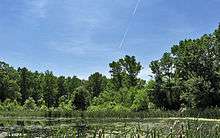
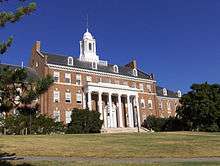
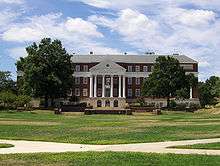
Colleges and universities
The University of Maryland, College Park, the flagship institution of the University System of Maryland, is located within the College Park city limits.
Primary and secondary schools
Public schools
College Park is served by Prince George's County Public Schools. The city is zoned to several different schools.
Elementary school students attend:
- Hollywood Elementary School (in College Park)
- Paint Branch Elementary School (in College Park)
- University Park Elementary School (in University Park)
- Mary Harris "Mother" Jones Elementary School (Adelphi CDP)
Middle school students attend:
- Greenbelt Middle School (in Greenbelt)
- Hyattsville Middle School (in Hyattsville)
- Buck Lodge Middle School (Adelphi CDP)
- College Park Academy Public Charter School (Hyattsville)
High school students attend:
- Eleanor Roosevelt High School (Greenbelt)
- High Point High School (Beltsville CDP)
- Northwestern High School (Hyattsville)
- Parkdale High School (Riverdale Park)
Private schools
- Al Huda School, K-12
- Berwyn Baptist School, PreK-8
- Friends Community School, K-8
- Holy Redeemer School, K-8
Museums
- The Art Gallery at the University of Maryland
- College Park Aviation Museum
- National Museum of Language
City-student politics
Like many college towns, College Park has had its share of political controversy. Occasionally, University of Maryland students plan voter registration drives and seek to elect one of their own to the city council. City residents, including students living within the city are eligible[20] to run for city council if they are at least 18 years of age. Over the past twenty years there have been multiple attempts, none of which were successful until Marcus Afzali won a seat in 2009.
- 1993 – Dana L. Loewenstein & Michael J. Moore – Perhaps the most controversial of all student races was that of Loewenstein, a former president of the Panhellenic Association, the sorority umbrella organization at the university. A year after she had lost the election, she was charged with 16 counts of perjury, 16 counts of aiding and advising to falsely register voters and faced a maximum prison sentence of over 200+ years. Ms. Loewenstein's opponent in the council race, Michael Smith, joined former council member Chester Joy in filing a complaint with the Prince George's County Board of Elections days before the Nov. 2 election in an effort to intimidate students from voting. The complaint alleged that 16 of her sorority pledges lived in one district but registered in another. The complaint was turned over to the state's attorney, who filed criminal charges against Loewenstein a year after she lost the election, despite no student voting illegally. The complaint alleged that all of the pledges lived in on-campus dorms but used the house address as their residence. Loewenstein was found not guilty by the Circuit Court.
- 2001 – Mike Mann & Daniel Dorfman – In November 2001, Michael Mann[21] and Daniel Dorfman, sought the two District 3 seats on the College Park City Council. Campaigning against incumbent Eric Olson and for an open seat created by then-councilman Brayman's decision to run for mayor, the two campaigned heavily to inform students there was a council race going on that year, and registered over 700 students to vote in the municipal election. Despite their hard work and an almost year-long campaign, they were defeated.
- 2007 – Nick Aragon – In January 2007, Nick Aragon lost a special election for the city council. Two incumbents created a vacancy when they were elected to higher county offices. In turn, the city was forced to hold a special election after the November 2006 elections. The city chose an election date during the university's winter recess, a time when many students were away from the city. With some help from the Student Government Association (SGA)[22] and an endorsement by College Park Mayor Steve Brayman, the Aragon campaign encouraged students to use absentee ballots, although few actually did, and Aragon lost the election.
- 2009 – Marcus Afzali – Marcus Afzali, a 24-year-old doctoral student in the Department of Government and Politics at UMD, won a seat on the city council representing District 4 in November 2009. Afzali attributed displays of "energy"—exemplified by taking time to knock on doors and reach out to residents—as the cause behind his success. The 2009 election is notable not only for Afzali's performance at the polls, but for the fact that both District 4 incumbents lost.[23][24]
References
Notes
- 1 2 "US Gazetteer files 2010". United States Census Bureau. Archived from the original on June 26, 2012. Retrieved January 25, 2013.
- 1 2 "American FactFinder". United States Census Bureau. Retrieved January 25, 2013.
- ↑ "Population Estimates". United States Census Bureau. Archived from the original on June 17, 2013. Retrieved June 26, 2013.
- ↑ U.S. Geological Survey Geographic Names Information System: College Park, Maryland
- ↑ "NOAA Center for Weather and Climate Prediction" (PDF). National Weather Service. National Oceanic and Atmospheric Administration. Retrieved 11 October 2016.
- 1 2 3 4 5 "Community Summary Sheet, Prince George's County" (PDF). College Park, Maryland. Maryland State Highway Administration, 1999. May 10, 2008.
- ↑ Suehsdorf, A. D. (1978). The Great American Baseball Scrapbook, p. 103. Random House. ISBN 0-394-50253-1.
- ↑ "NWS Sterling, VA – Sept 24 tornado report". National Oceanic and Atmospheric Administration.
- ↑ "Annual Estimates of the Resident Population for Incorporated Places: April 1, 2010 to July 1, 2015". Retrieved July 2, 2016.
- ↑ "Census of Population and Housing". Census.gov. Archived from the original on May 11, 2015. Retrieved June 4, 2015.
- ↑ "College Park, MD Factsheet". United States Census Bureau. Retrieved 2009-09-15.
- ↑ "American FactFinder". United States Census Bureau. Archived from the original on September 11, 2013. Retrieved January 31, 2008.
- ↑ "US Gazetteer files: 2010, 2000, and 1990". United States Census Bureau. February 12, 2011. Retrieved April 23, 2011.
- ↑ "College Park, Maryland Köppen Climate Classification (Weatherbase)". Weatherbase.
- ↑ "Comprehensive Annual Financial Report for the fiscal year ended June 30, 2015" (PDF). City of College Park, Maryland. November 20, 2015. p. 87. Retrieved October 26, 2016.
- ↑ National Park Service (2008-04-15). "National Register Information System". National Register of Historic Places. National Park Service.
- ↑ M-NCPPC Illustrated Inventory of Historic Sites: Prince George's County, Maryland (Prince George's County, Maryland), 2006.
- ↑ "Calvert Hills Historic District". Maryland Historical Trust. Retrieved October 29, 2008.
- ↑ www.wmucradio.com.
- ↑ Maryland State Board of Elections. "Voter Registration Introduction".
- ↑ Michael Mann
- ↑ "Student Government Association (SGA)".
- ↑ "- The Diamondback". Retrieved 27 July 2016.
- ↑ "Marcus D. Afzali (I)". The Washington Post. Archived from the original on September 30, 2012.
Further reading
- A Guide to the City of College Park, from the College Park City Hall.
External links
 Media related to College Park, Maryland at Wikimedia Commons
Media related to College Park, Maryland at Wikimedia Commons College Park (Maryland) travel guide from Wikivoyage
College Park (Maryland) travel guide from Wikivoyage Geographic data related to College Park, Maryland at OpenStreetMap
Geographic data related to College Park, Maryland at OpenStreetMap- Official website
- Route 1 Communities: College Park
- College Park Airport website
